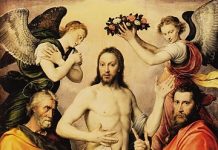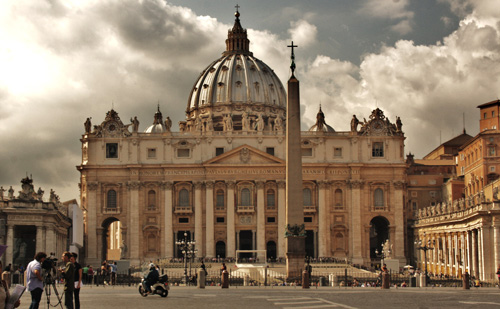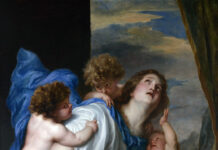Saint John Chrysostom (+407), an ascetic and contemplative monk who wanted only to retreat from the turmoil of life in the Eastern empire, was chosen first as a priest in Antioch, where he became renowned for his eloquent yet forthright and clear preaching (hence, his ‘surname’, Chrysostom, ‘golden mouth’). In 397, without his knowledge or consent, he was nominated as Patriarch of Constantinople, taking on the thankless task as the will of God.
John quickly antagonized both the Patriarch of Alexandria, Theophilus, who coveted his position, as well as, more importantly, Eudoxia, the luxury-loving wife of the Emperor Arcadius. In her anger, she had him banished twice; the first time, the much-loved Patriarch had to be recalled, as the people may well have revolted.
When the Empress had a statue of herself unveiled right in front of the cathedral in 404 (and one wonders how it portrayed her) John protested, and the vain Eudoxia flew into a rage worthy of a Disney villainness. Hell hath no fury, and all that. To prevent bloodshed, John surrendered to the authorities, going into exile, where he continued to write to his flock. Providentially, as one may take it, the cathedral burned down in a conflagration just afterward.
Living too long for his enemies, and still having too much influence for their liking, in 407 John was forced on a ‘long march’ through the most inhospitable of conditions by two implacable guards to the very boundaries of the empire, in the midst of which his body, already weakened, gave out, his last words being, Doxa to theo panton eneken (Glory be to God for all things). His body was eventually returned to Constaninople in 438 with great pomp and ceremony, and buried in the church of the Apostles.
Saint John is a doctor of the Church, and we have more of his salutary writings than almost any other, except Saint Augustine.
I will add a final note: Beware the biography on Wikipedia, which claims that John, in a fiery sermon condemning homosexuality, was the originator of the Church’s ‘homophobia’. The sin of Sodom, so sayeth the Wiki-editor, was seen, before John’s time, as a violation of ‘hospitality’, and not of the sin that would come to bear its name. This would come as news to Saint Paul, writing three centuries before Chrysostom, who took a rather dim view of men using other men as women and, pardon the pun, vice versa, as we just read yesterday at Mass:
Do not err; neither fornicators, nor idolaters, nor adulterers, nor the effeminate, nor sodomites, nor thieves, nor the covetous, nor drunkards, nor the evil-tongued, nor the greedy will inherit the kingdom of God.
God does indeed punish us, but only as a remedy for our moral evil, to bring us back to moral goodness, something the modern world, even amongst the Church, finds rather distasteful. Yet we may ask: Why some and not others? Why the people of the eastern seaboard and not the western, which seems, as a whole, to have strayed more from its moral moorings? And why do the good suffer along with the evil, the wheat with the tares? There are mysteries and mysteries, and as Christ declares, the eighteen people crushed by the tower at Siloam (Luke 13:4) were not more guilty than anyone else in Jerusalem. The guilt, such as it was, was more widespread.
It is in this light that we should see the hurricane barrelling down upon the Carolinas, and the typhoon headed towards Hong Kong. They are manifestations of God’s power, Who has authority over the ‘wind and the waves, and whose providence is ‘concrete and immediate’. Why He allows some to suffer and others not is a mystery, but we all have to go through the portal of death at some point to gain eternal life, each of us in his own time. All events in this life signify God in some way, however distant or near, and I suppose falling towers and hurricanes are at the very least a reminder that life in transitory, God is omnipotent, repentance is necessary, and our hubris, in this case our own control over the ‘wind and waves’, has its very circumscribed limits.












